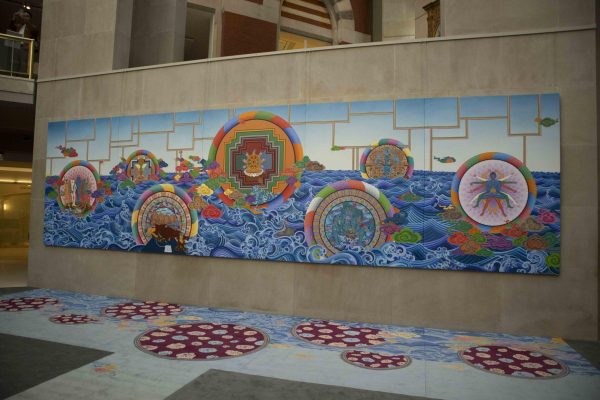Vibrant paintings of calm waves and clouds in shades of blue, yellow, pink, purple and brown span four walls at The Metropolitan Museum of Art. Mandalas are interwoven with contemporary socio-political commentary, decontextualizing the devotional symbols and diminishing their meanings.
The exhibition, “Mandalas: Mapping the Buddhist Art of Tibet,” combines ancient artifacts with contemporary works by Tenzing Rigdol — an artist trained in modern philosophy and Buddhist tradition. All pieces feature mandalas, which are religious motifs of circular Buddhist devotional patterns.
At the heart of the exhibition is “Biography of a Thought,” an installation by Rigdol. A large box adorned with a mandala is surrounded by four walls displaying multiple other mandalas. Rigdol strives to honor the rich tradition of Buddhist art by drawing connections between the traditional works on display beside his own contemporary installation. For instance, “Vajradhatu (Diamond Realm) Mandala,” a 14th century Tibetan piece, is drawn with distemper and gold on cloth and features the Buddha Vairochana at its center. Rigdol’s piece echoes the patterns and geometric designs in “Vajradhatu (Diamond Realm) Mandala.” The shapes and structures, traced across the modern artist’s skies, create a visual continuity that invites viewers to explore the past and present.

The exhibition places Buddhist transcendence in contrast with modern disharmony. One particularly striking mandala depicts a child hugging a gun, their face downcast amid a backdrop of vibrant flowers, a jarring commentary on gun violence in the United States. The most eye-catching image portrays George Floyd, sitting cross-legged with arms stretched out, in the pose of a Buddha.
Despite Rigdol’s intention to honor Buddhist traditions, the viewer can easily forget they are looking at artwork with religious significance. The drawings that center on political issues risk diminishing, rather than embracing, the positive journeys associated with mandalas, which are meant to focus on the accumulation of karma and reaching nirvana. Although the artwork is more easily understood by contemporary audiences without accounting for the religious implications, the circular shapes taken from mandalas lose their ideological complexity. These sacred symbols may be misunderstood or overlooked entirely.

Modifying these ancient artifacts with recognizable modern themes reinforces the stereotype of Asian art being elusive and inaccessible while it is, in fact, just of a different culture. These artifacts should be recognized and understood first for their rich spiritual meaning in the West before being incorporated into political commentary.
“Mandalas: Mapping the Buddhist Art of Tibet” attempts to teach a fresh lesson in Tibetan history and provides moments of relatability. Yet, it is more important to reflect on what is lost when artifacts are taken out of their cultural context. The Met’s new exhibition reshapes and simplifies Buddhist ideology to fit the predominant Western ideology instead of honoring tradition.
Contact Petunia Hu at [email protected].
























































































































































